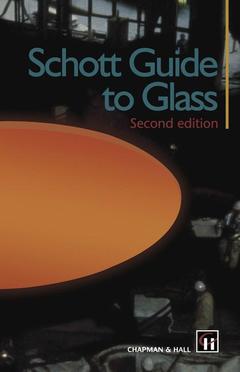Schott Guide to Glass, Softcover reprint of the original 1st ed. 1998
Langue : Anglais
Coordonnateur : Pfaender Heinz G.

The manifold forms and uses of glass are becoming increasing ly important in science, industry, and our personal lives. This constantly improving material interests a range of people extending beyond the relatively small number of glass experts. Naturally, questions arise as a result of this widespread interest. For this reason, we have heeded the publisher's suggestion to develop a glass primer which answers many questions and explains much of the terminology. The bases for this Schott Guide to Glass were the lecture manuscript, 'Glass Science for Designers' by Prof. Dr.-Ing. Heinz Pfaender, and the Schott pamphlet, Concepts of Technical Glass from A to Z. The manuscript which evolved into this book was written by members of the Schott scientific staff. We thank all those involved in producing this reference work. The Schott Guide to Glass will give experts, interested amateurs, and those who work with glass a glimpse into the diversity of this fascinating material. Mainz, Germany, September 1995 The editor Schott Glaswerke Introduction Glass is possibly the oldest man-made material, used without interruption since the beginning of recorded history. Unlike bronze or iron, however, it has not lent its name to any historical epoch. Still, the use of glass from hand-blown goblets to electronic components has grown with the rise of the industrial era and greatly affects present life. Glassmaking has always been one of the few truly integrated manufacturing processes where native minerals are transformed into an incredible variety of finished products within a single factory.
1 The history of glass.- 1.1 Glass in Egypt.- 1.2 A revolution in technology: the glassblowing pipe.- 1.3 Glass in the period of the Roman Empire.- 1.4 From luxury product to everyday item.- 1.5 The role of Venice.- 1.6 Glass in Germany.- 1.7 From art nouveau to modern glass design.- 1.8 On the path to glass technology.- 1.9 Otto Schott — founder of modern glass technology.- 1.10 Glassmaking in the USA (rough outline).- 1.11 Glass all over the world.- 2 Glass, the material.- 2.1 What is glass?.- 2.2 General characteristics of the glassy state.- 2.3 Broad classification of glass types.- 2.4 Raw materials for the manufacture of glass.- 3 The glassmelt.- 3.1 Melting furnaces and melting tanks.- 3.2 Fuels.- 3.3 The melting process.- 4 Flat glass.- 4.1 The production and use of common types of flat glass.- 4.2 Technical identification of soda-lime flat glasses.- 4.3 Other types of flat glass.- 4.4 Processed flat glass.- 5 Hollowware and glass tubing.- 5.1 The most important types of hollowware.- 5.2 The shaping of hollowware.- 5.3 The drawing process for glass tubing.- 5.4 Finishing of hollowware.- 5.5 Container glass.- 5.6 Glass tableware.- 5.7 Other hollowware.- 5.8 Finishing of hollowware.- 6 Special glasses and their uses.- 6.1 Fused silica (fused quartz or quartz glass).- 6.2 Borosilicate glasses for industrial and laboratory use.- 6.3 Pharmaceutical glass.- 6.4 Glasses for electrotechnology and electronics.- 6.5 Electrode glasses.- 6.6 Optical and ophthalmic glass.- 6.7 Glass fiber.- 6.8 Glass-ceramics.- 6.9 Porous glass and foam glass.- 6.10 A glance into the future.- 7 Environmental protection in the glass melting process.- 7.1 Glass melting.- 7.2 Waste disposal.- 8 Glass an an economic factor.- Glass museums.- Explanation of physical symbols and units.-Attenuation of radiation.- Technical literature on glass.
Date de parution : 05-2012
Ouvrage de 208 p.
14x21.6 cm
© 2024 LAVOISIER S.A.S.



